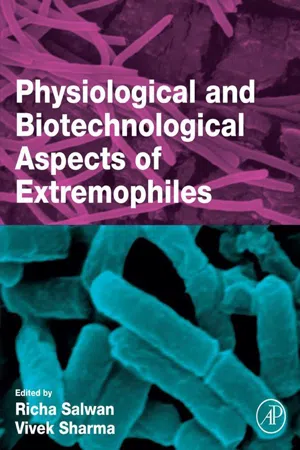Chapter 1
Overview of extremophiles
Richa Salwan1 and Vivek Sharma2, 1Department of Basic Sciences, College of Horticulture and Forestry (Dr. YSP - University of Horticulture and Forestry), Neri, Hamirpur (HP), India, 2University Centre for Research and Development, Chandigarh University, Chandigarh, India
Abstract
Extremophiles refer to the organisms which adapt their cellular machinery to perform under extreme stress conditions. Both prokaryotic and eukaryotic organisms like microalgae, fungi, lichens, protists, animals and plants can survive in extreme environmental conditions. Microbial extremophiles are categorized into psychrophiles, psychrotrophs and thermophiles based on temperature, alkaliphiles and acidophiles based on alkaline or acidic pH, peizophiles based on pressure, metal and radiation tolerant. All these extremophiles produce enzymes, exopolysaccharides, primary and secondary metabolites which find applications in food, detergent, pharmaceutical, leather, textile, paper and pulp, bioremediation and agricultural sectors. The metabolic products of extremophilic microbes offers properties such as high catalytic efficiency and stability, high salinity and alkalinity, low water activity, oxidant and bleach stability and more shelf life. The advancements of molecular tools including comparative genomics, proteomics, metagenomics and transcriptomics have provided a better way for exploring full metabolic potential of extremophiles. This chapter will provide a broad outline of extremophilic diversity and their habitats and attributes which could be used as suitable bioadditives in different industrial processes.
Keywords
Peizophile; Extremolytes; Enzymes; Halophiles
1.1 Introduction
Extremophiles are living organisms that have the ability to grow under conditions where normal organisms are not able to survive. These extremophilic organisms are always attracted towards conditions like extremely high and low temperature, extreme acidic or basic pH, high exposure to radiations, high salinity, low and high pressure, growth in presence of toxic wastes, organic solvents, heavy metals and other habitats which are harsh for normal survival. According to the growth conditions, extremophiles are categorized into extremophilic and extremotolerant organisms. The extremophilic category includes organisms which have the ability to grow under one or more extreme environmental conditions whereas extremotolerant includes organisms that normally grow under optimal conditions but can also survive on exposure to extreme environmental conditions [1]. The extremotolerant organisms are also known as extremotrophs [2]. Besides this, there are organisms which can tolerate more than one extreme condition like extreme temperature and pH, radiations, metals etc are known as polyextremophiles.
Extremophiles include prokaryotic bacteria and archaea as well as eukaryotic organisms. Among prokaryotes, most archaebacteria are extremophilic because of their high versatility and adaptive behavior towards extreme conditions. These archaea are salt loving, high temperature and acid tolerant, and strictly anaerobic. Archaea such as Pyrolobus fumarii are also known as hyperthermophiles as they can tolerate temperature up to 121 °C whereas bacteria Geothermobacterium ferrireducens can tolerate up to 95 °C [3,4]. Archaebacteria identified as Methanopyrus kandleri and Picrophilus torridus grow at high temperature 122 °C and 0.06 pH, respectively. Similarly, cyanobacteria are highly adaptive in combating extreme environmental conditions by forming mats with other organisms. These cyanobacteria can tolerate extremes of salt and metal concentrations, alkalinity and less water in dry areas but can’t tolerate low pH conditions [1]. Gloeocapsa spp. is an extremotolerant which can withstand extreme conditions in space such as temperature shifts, radiation and vacuum exposure. Similarly, spiral shaped Helicobacter pylori can survive extreme acidic environment of stomach. Previously, extremophile term was used to include organisms which are unicellular and prokaryotic but studies have reported that all extremophiles are not unicellular organisms [5].
1.2 Eukaryotic extremophiles
Eukaryotic multicellular organisms including fungi have well adapted physiology to survive in extreme conditions. Various microorganisms such as Chlamydomonas, Dunaliella, Euglena and Ochromonas, zooplankton, fungi and protists can grow and tolerate acidic and metal-rich conditions [6–11]. The fungal species can also thrive in acidic and alkaline environments, salt and metal tolerant but they cannot tolerate extremely high temperatures as they do not grow above 60 °C [12]. Species of Exophiala and Cladophialophora have the capacity to metabolize hydrocarbons to obtain energy and survive in polluted environments [13]. Micro-algae can also withstand extremophilic conditions as they are resistant towards light, high temperature, acidic or alkaline pH, CO2 and metal concentration [14]. In similar studies, a red algae Cyanidioschyzon merolae can adapt to extreme environmental conditions by regulating the expression of 35% genes in blue and red light [15]. Moreover, lichens such as Usnea antarctica and Umbilicaria cylindrica representing algal and fungal association can also tolerate extremes of low temperatures [16]. These lichens have the ability to do photosynthesis at subzero temperature and protects photosystems from damage [17].
Eukaryotic diversity has also been reported in acid mine drainage and certain aquatic environments [8,18–21]. A microscopic invertebrate Tardigrade also known as polyextremophilic organism can tolerate −272 °C temperature, dry and dehydrated conditions, high pressure and radiation exposure. Tardigrades undergo a process known as cryptobiosis to survive in extreme environmental conditions by suspending their metabolism. Tardigrades can survive in such extreme conditions for several years and become active during the onset of favorable environmental conditions [22]. Similarly, Artemia salina also known as Sea Monkey can survive in extreme of salt concentrations. Poecilia mexicana, a viviparous teleost can grow in environment when there are low oxygen availability and high hydrogen sulfide concentrations [23].
1.3 Prokaryotic extremophiles in diverse habitats
Microorganisms constitute the major component of the earth’s biodiversity. The species biodiversity under extreme conditions such as hot and springs, saline and alkaline lakes, hot and cold deserts, and ocean beds is mainly limited to microbes as these extremes are harsh for the existence of life. Even in space where harsh environment like extreme radiation, extreme temperatures, altered gravity, extreme salinity and nutrients restrict the growth of other organisms but do allow the growth of these microbes. Nearly 70% of the earth’s biosphere like Arctic, Antarctic, and moderately cold regions are having temperature below 5 oC [24–27]. Such cold environments are occupied by microorganisms categorized into psychrophiles and psychrotrophs. Psychrophiles are known to show optimum growth at or below 15 °C but are able to show g...
